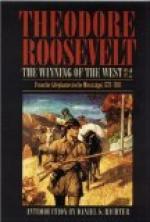This view of the case is amply confirmed by a consideration of what was actually acquired under the treaty of peace which closed the Revolutionary struggle. Map-makers down to the present day have almost invariably misrepresented the territorial limits we gained by this treaty. They represent our limits in the west in 1783 as being the Great Lakes, the Mississippi, and the 31st parallel of latitude from the Mississippi to the Chattahoochee; [Footnote: The map in Mr. Hinsdale’s book may be given as a late instance.] but in reality we did not acquire these limits until a dozen years later, by the treaties of Jay and Pinckney. Two points must be kept in mind: first, that during the war our ally, Spain, had conquered from England that portion of the Gulf coast known as West Florida; and second, that when the treaty was made the United States and Great Britain mutually covenanted to do certain things, some of which were never done. Great Britain agreed to recognize the lakes as our northern boundary, but, on the alleged ground that we did not fulfil certain of our promises, she declined to fulfil this agreement, and the lake posts remained in her hands until the Jay treaty was ratified. She likewise consented to recognize the 31st parallel as our southern boundary, but by a secret article it was agreed that if by the negotiations she recovered West Florida, then the boundary should run about a hundred miles farther north, ending at the mouth of the Yazoo. The discovery of this secret article aroused great indignation in Spain. As a matter of fact, the disputed territory, the land drained by the Gulf rivers, was not England’s to grant, for it had been conquered and was then held by Spain. Nor was it given up to us until we acquired it by Pinckney’s masterly diplomacy. The treaty represented a mere promise which in part was not and in part could not be fulfilled. All that it really did was to guarantee us what we already possessed—that is, the Ohio valley and the Illinois, which we had settled and conquered during the years of warfare. Our boundary lines were in reality left very vague. On the north the basin of the Great Lakes remained British; on the south the lands draining into the Gulf remained Spanish, or under Spanish influence. The actual boundaries we acquired can be roughly stated in the north to have followed the divide between the waters of the lake and the waters of the Ohio, and in the south to have run across the heads of the Gulf rivers. Had we remained a loose confederation these boundaries, would more probably have shrunk than advanced; we did not overleap them until some years after Washington had become the head of a real, not merely a titular, nation. The peace of 1783, as far as our western limits were affected, did nothing more than secure us undisturbed possession of lands from which it had proved impossible to oust us. We were in reality given nothing more than we had by our own prowess gained; the inference is strong that we got what we did get only because we had won and held it.




